Blowing across the waters of the Indian Ocean to the warm shores of Africa and Arabia, the North East monsoon carried on its winds Arab trading dhows on an ancient sea route. India’s maritime history was already an ancient one – kingdoms had been trading with West Asia and the Mediterranean since time immemorial. The port of Broach has a history stretching back 5000 years, to trade with Sumer and Babylon. Over the millennia, vessels laden with sandalwood, spices, muslin, indigo, diamonds, sapphires and all manner of luxury goods to delight and amuse the Roman Empire sailed along the slow coastal route to the Persian Gulf.
Adventurous seafarers, Arab sea captains were the first to master the use of the monsoon winds, and sail across the Indian Ocean, vastly reducing the length of their voyages. Setting up trading settlements along the East Coast of Africa, in the Persian Gulf, and along the West Coast of India, in Gujarat and Kerala, the Arabs were soon a well-established trading community. In Surat, and Cochin, Dar es Salaam, Mombassa, Lamu and Muscat, powerful and wealthy Arab merchants soon controlled trade across the Indian Ocean. The cargos that the Arab dhows carried were not very different form those of more ancient times – spices like pepper and cloves, coveted Indian cottons, gemstones, and timber for the wood starved Arabian Peninsula. The rich kingdoms of the “Empires of the Monsoon”, as Richard Hall called them, flourished. 
Stashed away in holds of the exotic dhows were large numbers of elaborately decorated wooden boxes which went by the evocative names of the places where they were crafted or bought – Shirazi, Basra, Surat, Bombay, Malabar….
Once produced in India and subsequently the Gulf, they were used as traveling trunks by workmen returning from the Gulf, sailors trunks, jewellers strongboxes, dowry chests, and were sold and traded in Zanzibar and Mombassa.
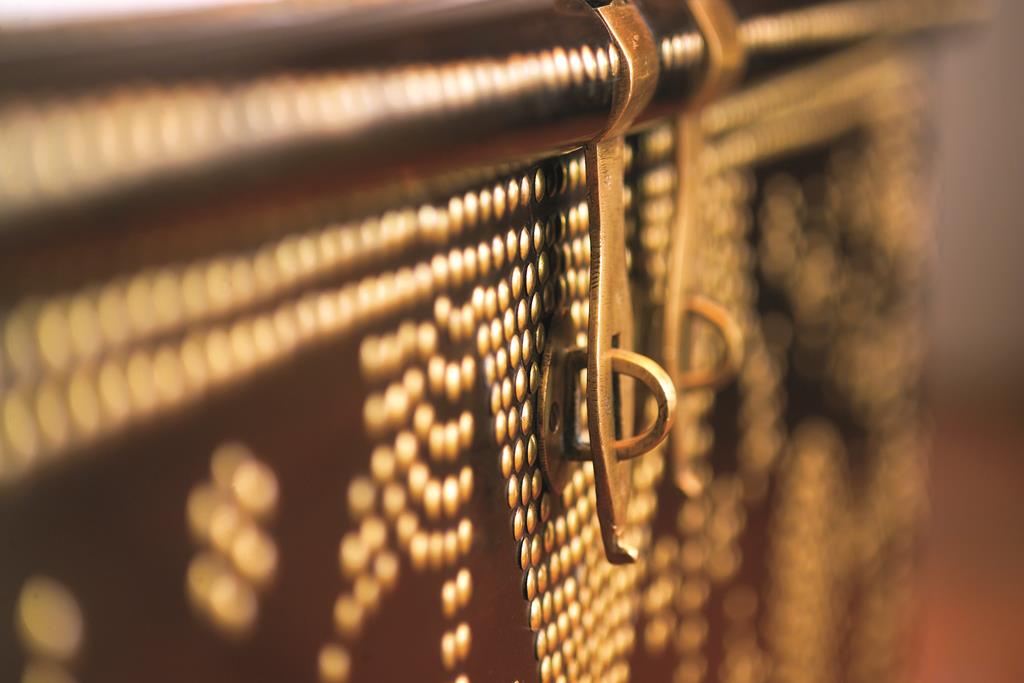
These boxes, found all over bustling port cities where the Arabs traded and settled, were originally crafted by Indian carpenters, and exported in large numbers from Bombay, Surat, and Malabar – hence the names. They were in great demand in the Arab world, as prized pieces of furniture, occupying pride of place in homes. Over hundreds of years of migrations, the origins of the chests became blurred, as they began to be reproduced in the Arabian Gulf, and the coastal cities of East Africa. They were usually classified by their distinctive hasps, hinges, handles, wood and style of decoration.
The prized Shirazi’s, Basra Chests, or Bombay Boxes as they were known – since they travelled from India to Shiraz, and then to Zanzibar, to be traded – were usually made of teakwood, and elaborately decorated with glowing brass sheets and studs in intricate patterns. The lids were decorated with corner mounts, knobs and hand made brass studs. The hasps, backplates and corners were of elegantly worked brass. The hinges were also highly decorative, ending in distinctive, decorative finials. The ornate mounts often had jali work, so that the wood of the chest showed through, and the brass, in the finer pieces, was incised with delicate patterns. They generally had stands, and narrow tills inside.

From the deep south, from the coast of Malabar, came the eponymous boxes made of dark, rich rosewood, or silky, tortoiseshell jackwood, carved with geometric patterns on the sides, or a typical motif of breadfruit, spreading gracefully from a central vase. The Malabar’s were quite distinctive, as they were the only ones, in the dhow trade, which were carved. Their lids often had lozenge shaped, pierced brass work. These chests did not have hasps, but were secured with just lock and key.
Another type, elaborately decorated with just handmade brass studs was quite unique in that the patterns appeared to vary according to the whims of the craftsman, patron or owner. Some of them had drawers at the base, which were also decorated. These chests, made of rosewood or shisham, were quite dramatically beautiful. Known as Najums, these days old pieces often come from Hyderabad – given the circular route many of these chests travelled, it is likely that they were brought back by travelling workmen or well to do merchants.
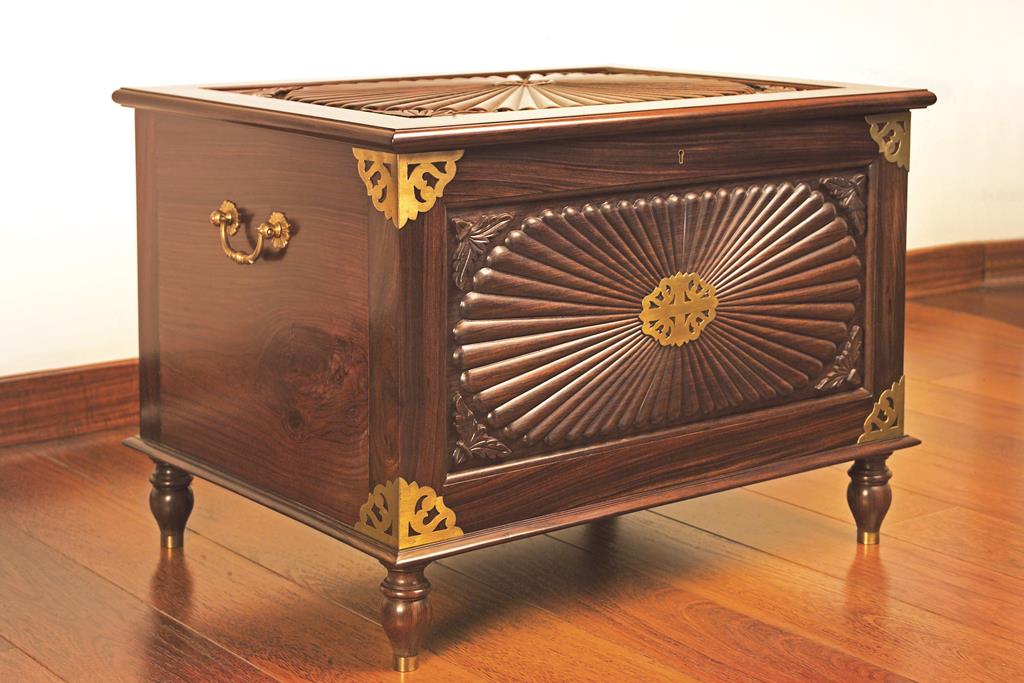
From the Gulf, the chests made their way on dhows to the exotic, clove growing, slave trading island of Zanzibar. Sailors sometimes worked on the chests on the voyage, to enhance their value, adding on brass studs The East Coast of Africa was known as the Land of Zanj, from the Persian word meaning ‘black” which lent it’s name to the island of Zanzibar. It was here, amongst the incredible mix of races, that these chests found their most eager buyers. Some of the famous chests located in museums belonged to the Sultans of Zanzibar, and others are to be seen in museums in the Gulf.
The chests were greatly sought after, both by moneyed merchants and ordinary seamen. It is likely that rich merchants commissioned designs, and the ones of the best quality were made to order. Chests were something of a status symbol, and the simpler, brass studded ones were owned by sailors, and contract workers returning from Basra to Gujarat, coming full circle to their place of origin.
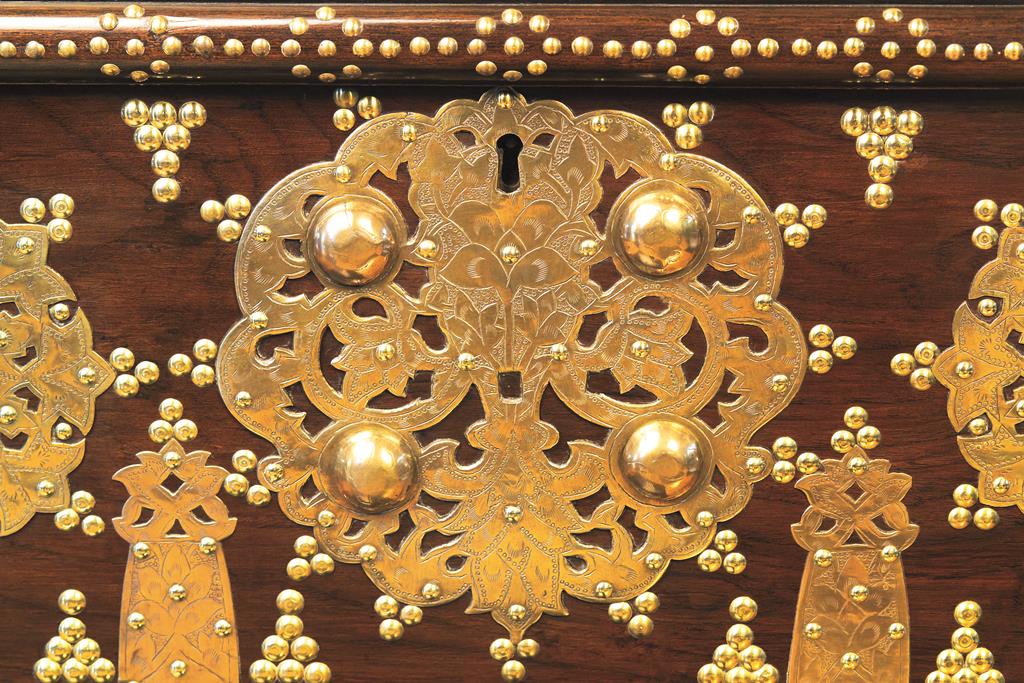
Some researchers have commented that these boxes are not to be seen in India, the country of their origin. It is true that at some stage, most Indian homes got rid of chests and boxes as unwieldy and cumbersome, as trends and lifestyles changed, and our regional museums appear to have given chests a miss. However, one of the finest collections exists with Mahendra Doshi, the Mumbai antique dealer, renowned around the world for his fine restoration work – the boxes are actually taken apart, brass and metal work included, and then put back together again. Doshi’s superlative collection includes Shirazis, Malabars, Shishams, Gujarati dowry chests and a plethora of cash boxes, writing cases, embroidery and vanity boxes. A very fine collection of Shirazis and Malabar chests were to be seen in the corridors of the Heritage Wing and foyer of the Taj Mahal Hotel in Mumbai, and also at the Taj Malabar, Lake Palace Hotel and Taj Coromandel, which were all, coincidentally, sourced
The origins and adaptations of these boxes, and the regional, cultural and religious influences on their designs is so astonishingly wide, that it appears as if the entire history of the sub-continent can be read in them.
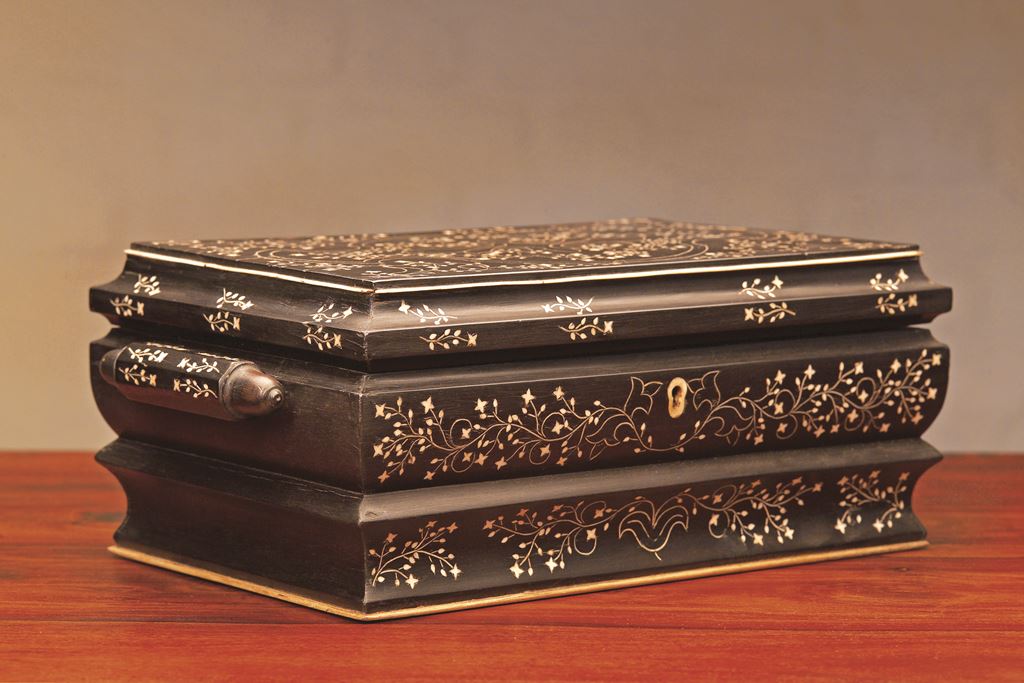
The trade with China over the centuries brought chests of fragrant camphor wood, much sought after as storage for textiles, as the wood was insect repellent. Some camphor chests and smaller boxes were carved with dragons, or ships in sail. Velvet lined embroidery boxes, inlaid with mother- of pearl and ivory, or ebony inlaid with ivory, in the most exquisite designs also made their way across from China.
The smaller boxes are even more interesting. They are frequently decorated with detailed inlay work in woods of contrasting colours such as white cedar and teak, and elaborate brass inlay in geometric and floral patterns. They open, sometimes in tiers, to reveal complex arrangements of compartments, sliding shelves and secret drawers that operate with spring mechanisms. The Indian craftsman lavished his imagination on the interiors of the boxes, each one more intriguing than the other. The writing cases have slots for pens and inkpots, and the cosmetic boxes, for perfumes. Ivory was another favourite decorative element, works of exquisite artistry emerging from the hands of the craftsman.
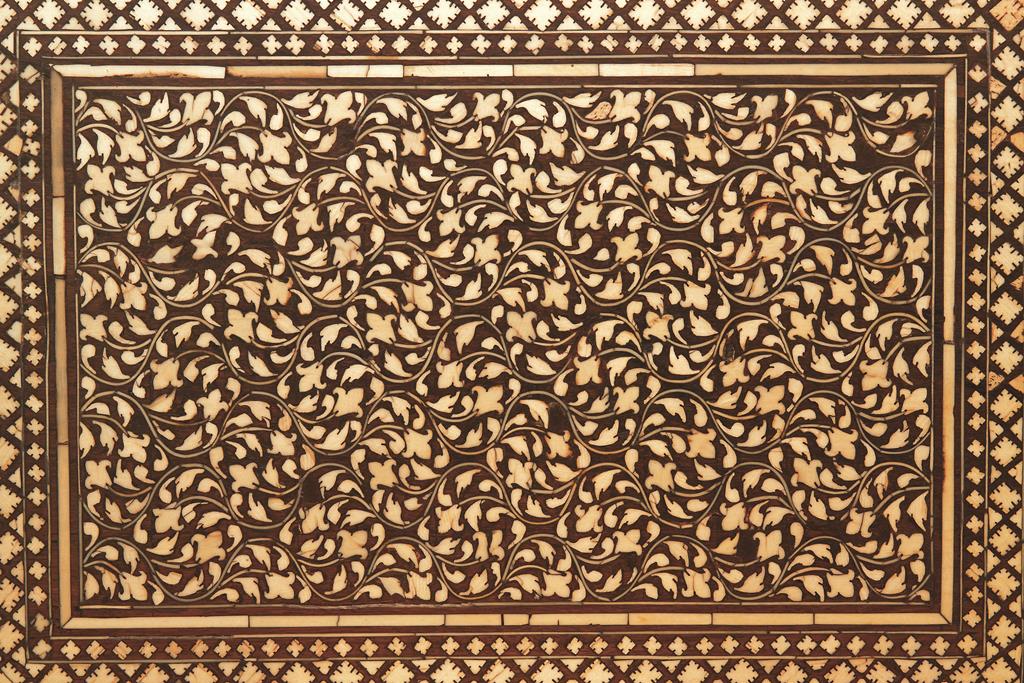
The Mughals inspired an entire lexicon of design in brass inlay work on wooden boxes, resulting in some of the most elegant, refined pieces. The star and moon motifs, minarets and the tree of life all identify these boxes.
The dowry chests of Gujarat are unique to the region, with their floral and geometric carving. Saurashtra, Kutch and Ahemedabad, each had their distinctive designs. These Majusas, dowry chests, were crafted from babul, or acacia wood in Kutch, easily identified by the decorative mirror work of the region. Saurashtra used teak, and parrots were a typical decorative motif. These chests were used to store utensils.

The top opening, slightly convex lidded, brass bound, ironclad Pataras, which had wheels, were used to store mattresses. The well to do chose rosewood, while others made do with just rosewood fronts.
The finest ivory inlay boxes came from Mysore and Vizakapatanam, and in the far north, Kashmir used locally grown walnut wood to make small, superbly carved boxes.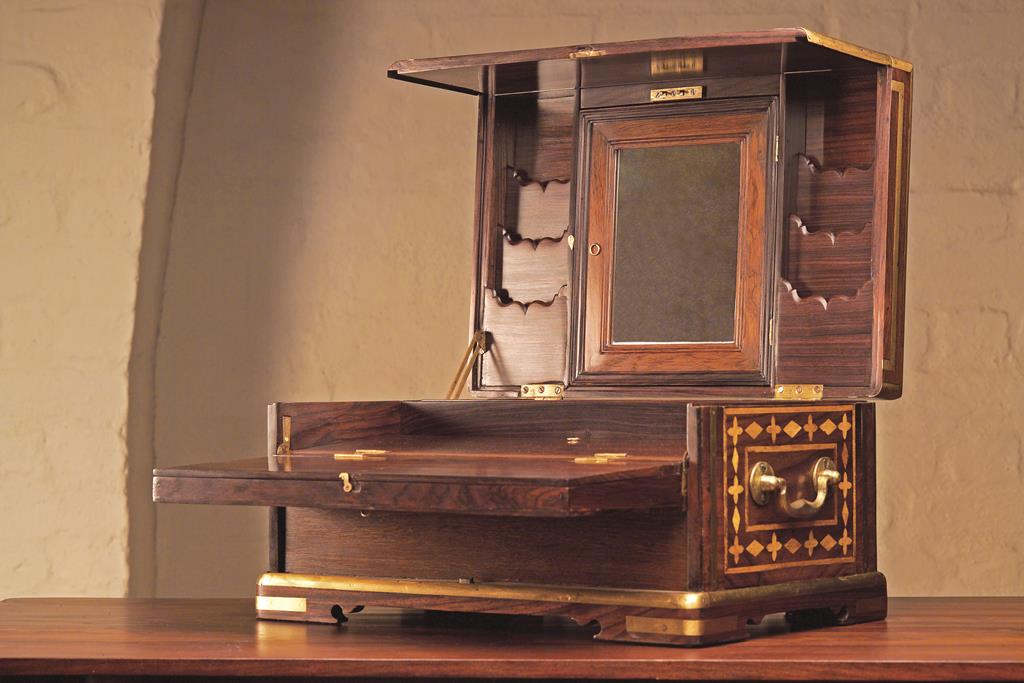
The Dutch and the Portuguese in their turn left a legacy of distinctive chests and cabinets .The Dutch preferred the play of contrasting woods to excessive ornamentation: mahogany and ebony or satinwood, jack wood and ebony for instance. The chests had a silky finish, with plain borders, and arabesques of simple floral patterns on the fretwork of their stands. The stands were fairly tall, no doubt to withstand the active insect life in tropical climates. These tend to be rare in India, but a good collection can be seen in the Dutch museum in Colombo, Sri Lanka.
For the Portuguese, the suryamukhi, or sunburst, was a passion, translated onto all their furniture, chests included. Some inspired pieces survive. Also from Portuguese Goa came another entirely unique piece – the vestry box, from churches and cathedrals, in all its classic simplicity. They were used to store robes, ceremonial clothing and records.
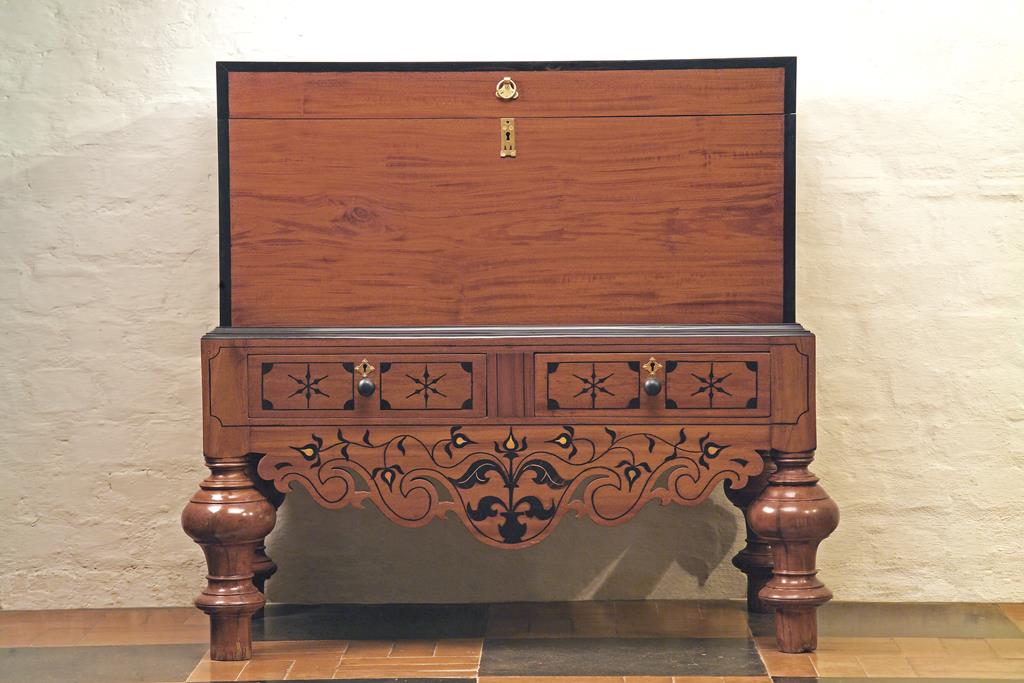
Just raising the lid of one of these superbly crafted pieces releases a whiff of bygone voyages, and forgotten stories of the lives of sailors, traders, merchants and scribes, wealthy upper classes and ordinary people. Boxes have traditionally been the repositories of all manner of treasures – concealed chambers, secret drawers, and complex, puzzle -like compartments have all added to the romance. Every home once boasted chests and boxes of different descriptions. Even the plain, solid teak chests were invaluable for protecting textiles from the punishing Indian climate. Who can forget the excitement of allowing grandmother’s exquisite silks slip though their fingers into the satiny depths of a camphor chest? Or being allowed to rummage through the treasures of a jewel case? Boxes hold memories, secrets and riches for everyone.
Acknowledgements::
All my knowledge of boxes, I owe to Mahendra Doshi, acquired over sixteen years of friendship, and un -clocked hours spent in his workshop and godowns. The credit for the title of this article goes to him.
Image Courtesy Taj Magazine

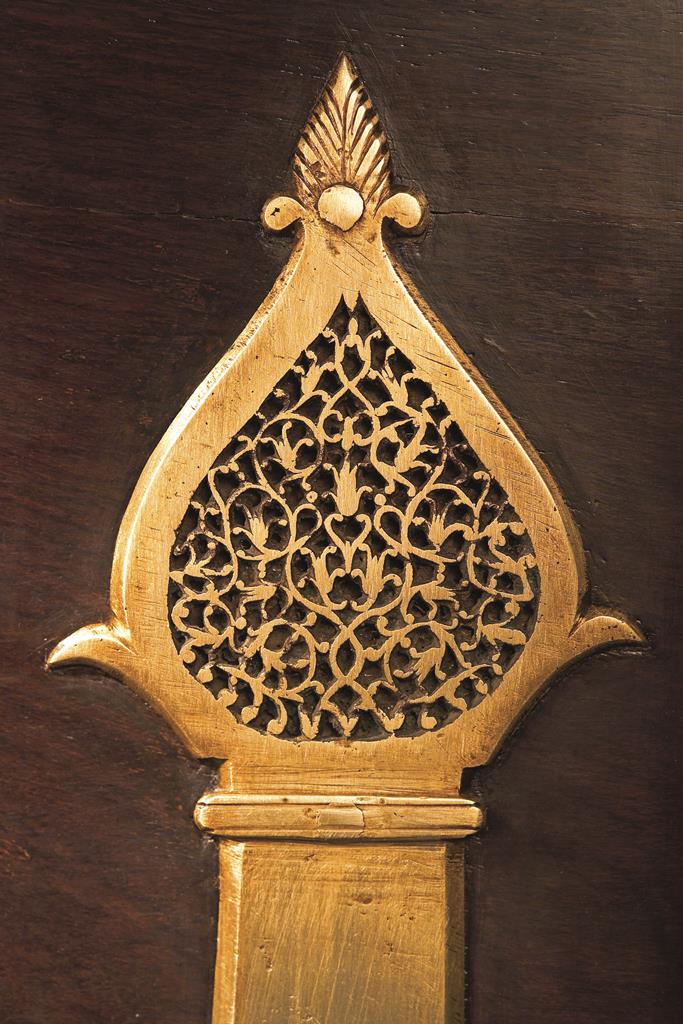



Very good information. I am an antique dealer. These chests are still available here and people still buy and keep them in their houses as show pieces. I just love them.
Hi I do Collect and sell old Furniture from Rajasthan Gujarat and South India. My mobile number is 09414196516
I so hav some nice chest . I collect and sell. My mobile number is 09414196516
Good information. I have a very nice Zanzabar Wedding Chest but one of the front locks needs to be replaced. Any idea where I could find one? I’ve looked on line but the largest I can find is 3-1/2 inches wide. The old ones on the chest are 4-1/2 inches. Thanks.
I believe I may have a Najum chest. It is blanket chest size and in a dark wood with a double studded surround. There are 3 drawers at the base and all brass decoration and handles are original.The brass design is remarkably similar if not the same, as in picture no. 6, in your ‘Boxes of Riches’ article . I would appreciate your comments on this highly decorative chest.
Thank you very much for writing in Jan. The chest that you describe as being very similar to image no 6 sounds like a classic ‘Basra’ chest. The image in the article is of a Basra/Shirazi from my personal collection, which also has the 3 drawers at the base that you have described. These were-and are-highly prized, and have become very difficult to find, so you are fortunate to have one in your possession! Malabar chests are quite different, without the typical brass studs of the Basra, and more wood carving. Image no 4 shows a detail from a Malabar chest. The Basras, as mentioned, were carved in India, and exported to ports along the dhow trade routes. Just as a aside, while travelling in Oman last year, I saw small, modern reproductions of these Basra chests being carved and put on display for sale in the Souk at Nizwa,the old capital of Oman. I hope this was of some help.Best wishes. Kaveri
Having researched various sites ,I have been unable to establish the origin of a very old rectangular chest I own. It is large with 3 lower drawers , brass inlay in the style of Malabars I believe, and with double studded surround made in mahogany or a dark wood. It is highly ornate with all original handles and latch lock. Do you have any ideas of its origin ?
Yours sincerely
Jan Adamson
It was such a delight to read about these treasures! Would you be aware of any craftsmen in India that still do such work, perhaps not so intricate though.
Thanks and Regards,
Smita
Hi Smita, thank you for writing in, I’m glad you enjoyed the article. To the best of my knowledge, these kind of chests are no longer being made on a regular basis, but I am sure there are some antique dealers who will make reproductions of the simpler designs. Do check out this link:
I hope that’s useful.Best wishes.Kaveri
I have collected boxes all my life and a now lucky enough to have inherited a Shirazi chest from my father. I was doing research on how to polish the brass when I found you site. If you have any tips for me in that regard, I would be oh so grateful. Thank you for your interesting and informative blog.
Hello, thank you for writing in, I’m glad you enjoyed the article about boxes. I could go on about them,they are such a part of my life, and hold so many stories. Congratulations on your Shirazi, they are very special. You don’t mention where you live, but the place I go back to, when my chests and boxes need their woodwork and brassware polished is Mehendra Doshi Antiques, Mumbai, they are absolutely the best. Here’s a link: http://www.mahendradoshi.com/about.html. And a telephone number: 022-23630526. I hope this is helpful! Best wishes. Kaveri
It is a very interesting research study you have put up. I appreciate the effort put in to bring out the understanding of heritage and traditional crafted Indian chests.I couldn’t find any information on NETTUR PETTI or the Kerala traditional jewelry box. I f you have any input or info on the same please care to share to me. I am doing research on this very craft from Kerala.
thank you for sharing rich heritage of boxes! it was a splendid journey through your article.I have had pleasure of viewing many a collector’s boxes ,but you described the history very well.thank you!
Chests and boxes hold a special fascination for many of us, Geeta, I’m so glad you enjoyed the article,thank you for writing in. I was very fortunate to have as a very good friend,the late Mahendra Doshi, who was a fund of knowledge on antique boxes, a knowledge he very generously shared. I’m sure you have seen some extraordinary pieces yourself. Kaveri
Hi Kaveri, I have always been a “Chest Nut”. And your article has opened my eyes to much information. Thank you.
Hello Naina, I’m glad you enjoyed the article. These boxes and chests have a fascinating history, and have travelled a lot, so every one of them carries stories – if only we could hear them all! Best. Kaveri.
Kaveri, you have a fan in me!
this pandora’s box of treasures that i am so lustily feasting on …all thanks to your wonderful husband for introducing me to your fascinating world…
chests have always intrigued and and now i am little more richer in my knowledge about them. gracias!
pls don’t be surprised if you find a post a bit too often from me 🙂
looking forward….
Hello Simrat, thank you very much for reading and appreciating this article.Chests and boxes hold a special fascination for me too – they are so full of stories and possibilities. You are most welcome to post as often as you like, responses from people is what keeps me motivated.Best wishes, Kaveri
Congrats!! I really appreciate your constant efforts in bringing the fragile reminders of the past culture and heritage to the foreground..the blog promises to be a cultural treat,,
Look forward to more..
Deepa Subramanian
Hi Deepa, thank you very much for taking the time to write down your impressions. I hope that you enjoy reading the articles on these pages. Best wishes, Kaveri.
Congrats,I really appreciate your constant efforts to bring the fragile reminders of the past culture and heritage to the foreground..the blog promises to be a cultural treat..Look forward to more.
Deepa Subramanian